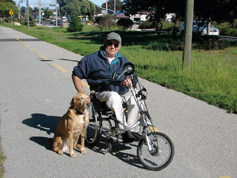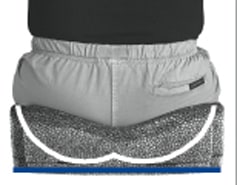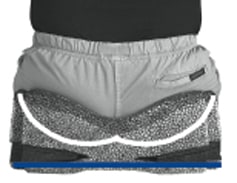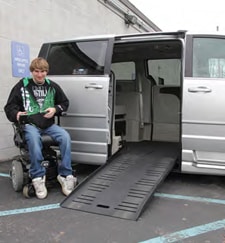
Aerobic Exercise with Minimal Equipment
By Richard Holicky
“I need to get some exercise,” is a common refrain among wheelers, and with good reason. Pushing a manual chair does not adequately tax the cardio and respiratory systems. Over the long haul it can even result in non-reversible damage and tightness, due to repetitive motion, overuse of specific muscle groups and underuse of others. In addition, lack of movement leaves us less flexible and more prone to the ravages of arthritis.
The challenge of getting a true aerobic/cardio workout is lack of access to large muscle groups in the lower body. Without engaging the quadriceps, hamstrings, glutes and other lower extremity muscle groups, prolonged moderate-level aerobic exercise (heart rate of 150 beats per minute for a 30-year-old) may be difficult to achieve. However, here are some less expensive equipment options that utilize upper body muscle groups and might make a dent.

Table-top handcycles offer the opportunity to work the shoulder muscles, increase respiration rates and elevate heart rate. Wheelers have a wide variety of options, ranging from low cost Easy-Cycles (Amazon, Wal-Mart — $50-150) to the sophisticated and pricy Saratoga Cycle ($600 and higher). Advantages include relatively light weight and portability, low impact and the opportunity to pedal backward to work underused muscle groups.
Handcycles are a step up from table-top cycles. They can require a significant commitment of time and money, but the workout, increased mobility, and sense of satisfaction could be worth it. Decent quality used handcycles can be purchased at reasonable prices from Bike-On.com. Besides overcoming the boredom factor, extra benefits of handcycling include fresh air, sunshine, savage tan lines, style points and changing flat tires.
Thera-Bands offer quick, easy and affordable exercise and stretching benefits. Look for Thera-Bands in two forms: the giant rehab rubber bands in blue, red or green, or the tubing with handles. Both are effective; each has upsides and downsides. The rubber bands are super portable and their length can be adjusted either with scissors or by the number of times they’re wrapped around your hands. Focus on motions that open up the chest and shoulder girdle to compensate for the repetitive motion of wheeling. Stretch the bands from straight out in front of the body out to the sides of the body; from directly overhead down to the sides; or by anchoring one hand to a wheel rim and extending the other arm across the body.
Anchor the bands under a heavy chair or sofa leg and pull the bands up and out to the sides of the body, focusing on pulling your shoulder blades together and expanding your chest. For variety, and to simulate rowing aerobics, pull the bands straight back to the chest. Emphasize the aerobic benefit by lightening up on tension and focusing on reps, lengthening your workout over time.
Rubber bands can also be used to simulate curls by anchoring the bands under your feet or under a door. Most of these stretching exercises can also be done with the handled tubes by anchoring them under heavy furniture or cabinet handles. The handled tube bands offer more comfort, as well as something to attach a Velcro glove to.
Free weights are for the truly committed, are reliable, indestructible and can build strength rather quickly. But there are downsides: lack of versatility, non-portability and the importance of proper form. While proper form is somewhat important to the effectiveness of all this equipment, form is especially important with free weights. The variety of exercises is huge and you can focus on specific muscle groups: biceps, triceps, lats, delts, pecs, etc.
Swimming can provide a real aerobic workout as well as stretch your whole body. The cost is relatively inexpensive. Buy a monthly or quarterly card at a municipal pool. More and more public facilities, especially newer ones, are wheeler friendly, both locker room and pool lift-wise. You don’t need anything except your body and swim apparel for this exercise, but you can get protective footwear to avoid scrapes on rough pool surfaces at a dive shop.
Whatever you do, as with any new program, the biggest hurdle is inertia — simply getting started and staying with it. Experts say it usually takes about 21 straight days of doing something to make it a habit. Exercising two to four times a week will take longer and require a firm commitment to establishing and sticking to a schedule.
Music and visuals boost motivation. Commit to doing some exercise through one song, one commercial or one YouTube video. Often you’ll get in a groove and go much longer. Rather than setting an ambitious goal like “I’ll work out four times a week,” plan to do a “one-Song/commercial/video workout” on Monday and Thursday. Leave yourself room to overachieve — going longer is what will keep you hooked.
Changing Conditions Means Changing Cushions
By Tim Gilmer
There are many reasons for changing a cushion, but here are some situations — common and uncommon — when a change is called for.
• When you get a decubitis ulcer. A foam cushion will become compressed over time, lose volume, and no longer offer protection. A gel cushion can break down or become compressed. An air cell cushion can be improperly inflated or spring a leak. Or you may have the wrong cushion type — literally not what the doctor or physical therapist ordered. Or they may have misjudged the level of protection you actually need to avoid decubiti. If the cushion doesn’t do its job, it’s time to change.
When you have a developing pressure sore, it’s best to change to a cushion that offers more protection rather than try to fix the one you have.

• When aging causes skin to lose elasticity. We all want to stay young, but denial can cause problems. Just because you have always been OK with a certain type of cushion doesn’t mean it will always give you the protection you need. Our bodies change, and as we age, our skin breaks down more easily. Look for the first signs of redness, skin irritation — however minor — or excessively dry skin. These usually signal a change in resistance to skin problems.
• When your activity level or working posture changes. Sometimes a change in employment or habits causes us to sit in a way that increases pressure. A change from actively moving around during the day to sitting very still (in front of a computer or television, or spending a lot of time in a recliner) lengthens the time you sit without adjusting your position — increasing duration of pressure without relief. If you can’t change the need to sit for long periods, it may be time to change cushions, or use one type of cushion when you are sitting still and another when you are active.
The same thing can happen in reverse. When I was younger, I started a construction project with a friend. The two of us gutted out an old pig barn and converted it to a greenhouse. I did a lot of lifting and pulling and bending over in my chair to drive nails or pry nails up or use a drill. The postural changes activated sheer forces — when your skin stretches thin. I was using a low-profile ROHO at the time and had never had problems. But I got a sore due to changes in working posture and increased activity. I changed to a high-profile ROHO cushion and the sore healed on its own.
• When a medical condition or procedure robs you of strength or changes your body.After a coronary artery bypass graft operation, I lost strength from not being able to use my arms (the same thing can happen after shoulder surgery). I found it impossible to transfer into the elevated seat in my minivan, which was not a lowered conversion. Changing from a high-profile air cell cushion to a firmer Varilite cushion gave me extra height and better push-off power, just enough to be able to transfer after practicing for a week or so. In time I regained my strength and was able to return to a high profile cushion.

Just recently, after I had to have my lower left leg amputated, making simple transfers became a real problem. The radical change in my body threw me for a loop, and it wasn’t just the lack of support from no longer having a left foot. It was the way the human skeleton works. When transferring, my left leg, without support, suddenly dipped down. The bones on my left side, from shin to knee to thigh to coccyx to rib cage, all connected, followed the downward momentum. I missed several transfers, falling out of my chair, before I realized I had to change to a Jay-ROHO hybrid with an air cell interior and a hard foam border that made me sit higher, in combination with a strap that tethered my left leg to my right.
Wheelchair users with progressive conditions may find it necessary to change seating systems. Correct posture can become very difficult when your muscle strength wanes. You may want to consider a Ride Designs cushion at this time, pre-molded to fit your unique body, along with a more supportive back or head rest.
All of these situations have one thing in common — they demand awareness and willingness to change in order to stay free of skin problems or other complications.
RESOURCES
• Jay Cushions, 800/385-6220; www.jaycushions.net
• Ride Designs, 866/781-1633 or 303/781-1633; www.ridedesigns.com
• ROHO Cushions, 800/385-6220; www.rohocushions.net
• Varilite, 206/505-9500 or 800/827-4548; www.varilite.com
Insuring Your Adaptive Vehicle
By Mark E. Smith
When Josh McDermott, 21, received the news that New York state’s Vocational Rehabilitation program had approved a highly-modified $120,000 wheelchair-accessible van so that he could drive himself to work, he was thrilled. However, as McDermott, who has Becker muscular dystrophy, began shopping for auto insurance, his joy turned into dread. “My insurance broker got quotes in the $500 per month range,” explains McDermott, who requires a ramp van and full drive-by-wire electronic hand controls. “It was as if I was insuring a Ferrari.”

McDermott was even more shocked when he learned that although the insurance quotes were based on the complete modified van purchase price of $120,000, the insurance wouldn’t ultimately cover that in an accident. Only book value of the base van would be paid in the event of an accident — around $25,000 — but no coverage would be in place for the over $80,000 in accessibility modifications, considered uninsured custom equipment. It was a true Catch-22 — paying an outrageous amount for insurance that wasn’t truly insurance after all.
McDermott found himself asking the question that many have about their accessible vehicles: How does one fully insure adaptive equipment at an affordable rate?
Insurance 101
With any driver, insuring an accessible vehicle begins with individual demographics. The driver’s age, marital status, driving record, occupation, gender, and geographical location all come into consideration in pricing premiums. However, insurers cannot legally charge more based on disability, so it’s not a consideration in the process.
The issue is in the area of what the insurance industry calls “vehicle modifications.” Vehicle modifications define equipment that’s not part of the base vehicle’s original equipment — whether custom rims or hand controls. Therefore, any accessibility equipment and modifications must be defined and insured beyond the base vehicle, at greater cost. As The Hartford Financial Services Group officially states, “Insuring a significantly modified vehicle, which increases the value of the vehicle, will cost more than the same non-modified vehicle, if the modifications are insured for physical damage — comprehensive and collision coverage. Liability coverage is not affected by vehicle modifications. If the modifications are not insured, premium will not be impacted.”
How Vehicle Modifications Are Insured
There are several ways to insure modifications in an accessible vehicle — and it all begins by explicitly stating the modifications when shopping for insurance. In an “agreed value” policy between you and the insurer, in the event of an accident, a non-depreciated value will be paid for the vehicle. A “stated cash value” policy covers the entire modified vehicle, but accounts for annual depreciation. Of the two, “stated cash value” policies are typically less costly.
Another common way to insure vehicle modifications is with a “rider” policy, a customized addition to a standard policy that adds coverage for vehicle modifications — at added cost. With this option, you can shop around and choose which modifications to insure and which company has the best total package for coverage and prices.
Interestingly, the United Services Automobile Association, an insurer only open to retired and active members of the military and their families, offers among the most unique and cost-effective insurance routes for accessible vehicle modifications. USAA allows members with both USAA auto and homeowner’s insurance to insure accessible vehicle modifications under the homeowner’s policy, while retaining the base vehicle’s comprehensive coverage as a low-cost policy. “By going with USAA under my parents’ policy, I was able to get my insurance down below $200 per month,” notes McDermott, whose career as a mobility industry consumer advocate has flourished since being able to drive himself up and down the East Coast. “I’ve been putting 1,000 to 2,000 miles per month on my van, and it’s changed my life, making me independent.”
Getting the Most For Your Money
Virtually every insurer has its own model for whether and how it insures accessible vehicle modifications — and some won’t insure a “modified” vehicle. Therefore, it’s important to shop extensively for not only the best price, but also the most complete coverage of the modified equipment. As McDermott puts it, “What I learned in insuring my new van is that it’s not just a matter of considering policy pricing and money-saving tricks like going with a higher deductible, but most importantly, making sure that you truly have complete coverage on your vehicle’s modifications.”
Support New MobilityWait! Before you wander off to other parts of the internet, please consider supporting New Mobility. For more than three decades, New Mobility has published groundbreaking content for active wheelchair users. We share practical advice from wheelchair users across the country, review life-changing technology and demand equity in healthcare, travel and all facets of life. But none of this is cheap, easy or profitable. Your support helps us give wheelchair users the resources to build a fulfilling life. |


Recent Comments
Bill on LapStacker Relaunches Wheelchair Carrying System
Phillip Gossett on Functional Fitness: How To Make Your Transfers Easier
Kevin Hoy on TiLite Releases Its First Carbon Fiber Wheelchair